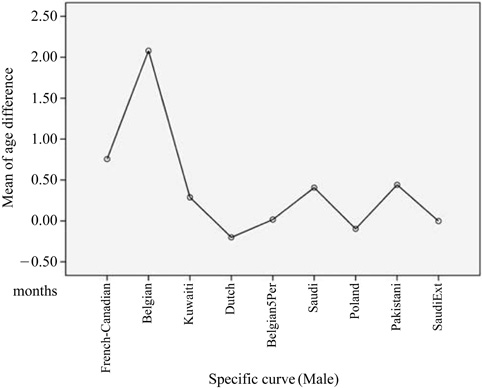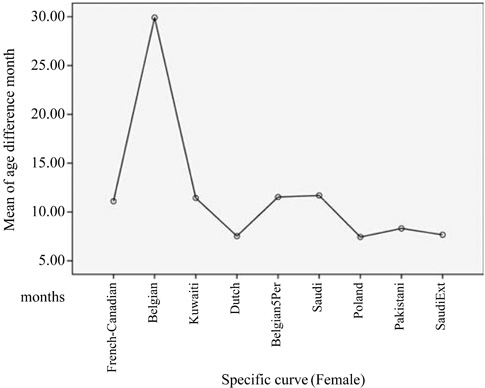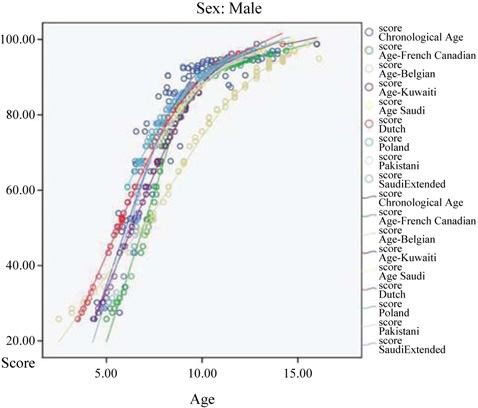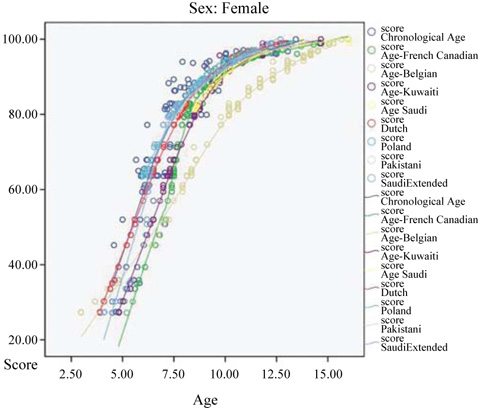Imaging Sci Dent.
2013 Dec;43(4):267-272. 10.5624/isd.2013.43.4.267.
Dental maturity of Saudi children: Role of ethnicity in age determination
- Affiliations
-
- 1Department of Preventive Dentistry, Riyadh Colleges of Dentistry and Pharmacy, Riyadh, Saudi Arabia. ziadbaghdadi@riyadh.edu.sa
- KMID: 2229610
- DOI: http://doi.org/10.5624/isd.2013.43.4.267
Abstract
- PURPOSE
Demirjian's dental maturity scores and curves have been widely used for human age determination. Several authors have reported considerable differences between the true and estimated age based on the Demirjian curves, which have been accounted for by ethnicity. The purpose of the current study was to assess the role of ethnicity-specific dental maturation curves in age estimation of Saudi children.
MATERIALS AND METHODS
A sample of 452 healthy Saudi children aged 4 to 14 years were aged based on the original French-Canadian Demirjian curves and several modified Demirjian curves specified for certain ethnic groups: Saudi, Kuwaiti, Polish, Dutch, Pakistani, and Belgian. One-way ANOVA and a post hoc Scheffe's test were used to assess the differences between chronological age and dental age estimated by the different curves (P<0.05).
RESULTS
The curves designed for Dutch, Polish, Saudi, and Belgian (5th percentile) populations had a significantly lower error in estimating age than the original French-Canadian and Belgian (50th percentile) curves. The optimal curve for males was the Saudi one, with a mean absolute difference between estimated age and chronological age of 8.6 months. For females, the optimal curve was the Polish one, with a mean absolute difference of 7.4 months. It was revealed that accurate age determination was not related to certain ethnicity-specific curves.
CONCLUSION
We conclude that ethnicity might play a role in age determination, but not a principal one.
MeSH Terms
Figure
Reference
-
1. Lee YL, Teitelbaum S, Wolff MS, Wetmur JG, Chen J. Comparing genetic ancestry and self-reported race/ethnicity in a multiethnic population in New York City. J Genet. 2010; 89:417–423.
Article2. Abel EL. Arab genetic disorders: a layman's guide. Jefferson, NC: McFarland & Co.;2003. p. 4.3. Roche AF, Sun SS. Human growth; assessment and interpretation. Cambridge: Cambridge University Press;2003.4. Willems G. A review of the most commonly used dental age estimation techniques. J Forensic Odontostomatol. 2001; 19:9–17.5. Black S, Aggrawal A, Payne-James J. Age estimation in the living: the practitioner's guide. Hoboken, NJ: Wiley-Blackwell;2010.6. Demirjian A, Goldstein H, Tanner JM. A new system of dental age assessment. Hum Biol. 1973; 45:211–227.7. Chaillet N, Willems G, Demirjian A. Dental maturity in Belgian children using Demirjian's method and polynomial functions: new standard curves for forensic and clinical use. J Forensic Odontostomatol. 2004; 22:18–27.8. Leurs IH, Wattel E, Aartman IH, Etty E, Prahl-Andersen B. Dental age in Dutch children. Eur J Orthod. 2005; 27:309–314.
Article9. Al-Emran S. Dental age assessment of 8.5 to 17 year-old Saudi children using Demirjian's method. J Contemp Dent Pract. 2008; 9:64–71.
Article10. Rózyło-Kalinowska I, Kiworkowa-Raczkowska E, Kalinowski P. Dental age in Central Poland. Forensic Sci Int. 2008; 174:207–216.11. Qudeimat MA, Behbehani F. Dental age assessment for Kuwaiti children using Demirjian's method. Ann Hum Biol. 2009; 36:695–704.
Article12. Sukhia RH, Fida M, Azam SI. Dental age table for a sample of Pakistani children. Eur J Orthod. 2012; 34:77–82.
Article13. Hegde RJ, Sood PB. Dental maturity as an indicator of chronological age: radiographic evaluation of dental age in 6 to 13 years children of Belgaum using Demirjian methods. J Indian Soc Pedod Prev Dent. 2002; 20:132–138.14. Koshy S, Tandon S. Dental age assessment: the applicability of Demirjian's method in south Indian children. Forensic Sci Int. 1998; 94:73–85.
Article15. Prabhakar AR, Panda AK, Raju OS. Applicability of Demirjian's method of age assessment in children of Davangere. J Indian Soc Pedod Prev Dent. 2002; 20:54–62.16. Baghdadi ZD. Dental maturity in Saudi children using the Demirjian method: a comparative study and new prediction models. ISRN Dent. 2013; 2013:390314.
Article17. Baghdadi ZD, Pani SC. Accuracy of population-specific Demirjian curves in the estimation of dental age of Saudi children. Int J Paediatr Dent. 2012; 22:125–131.
Article18. Liversidge HM, Speechly T. Growth of permanent mandibular teeth of British children aged 4 to 9 years. Ann Hum Biol. 2001; 28:256–262.
Article
- Full Text Links
- Actions
-
Cited
- CITED
-
- Close
- Share
- Similar articles
-
- Correlations between dental and skeletal maturity
- Skeletal Maturity Evaluation using Maxillary Canine Development in Growing Children
- Evaluation of Skeletal and Dental Maturity in Relation to Vertical Facial Types and the Sex of Growing Children
- Study on estimating skeletal maturity of hand-wrist using multiple regression model
- A study on the comparisons between dental calcification and skeletal maturity







